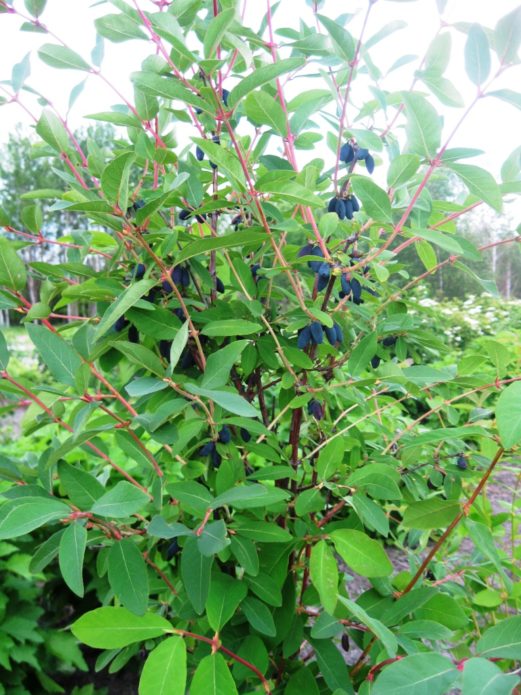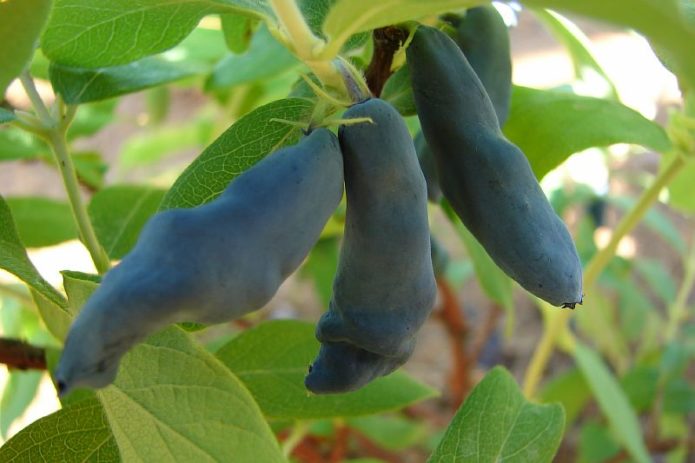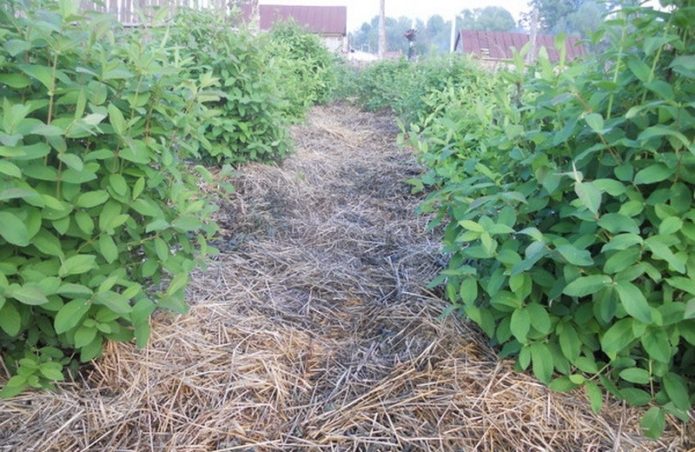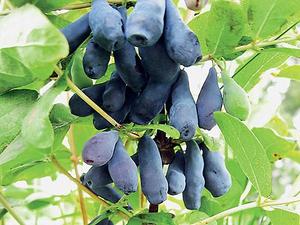Honeysuckle ceases to be a rare guest in summer cottages. If more recently it was perceived as a wild shrub, now more and more gardeners are trying to plant several bushes in their homes to get early vitamin berries. The number of honeysuckle varieties is growing rapidly, but the Nymph variety, which appeared at the end of the last century, is still considered one of the best.
Content
Description and characteristics of honeysuckle nymph
The honeysuckle variety Nymph is one of the most famous and popular. And although most of the varieties available are quite similar to each other, the Nymph has a certain aura that sets it apart from others.
Origin of the variety
For a long time, honeysuckle grew mainly in Siberia and the Far East, where it was not grown in gardens, but berries were picked in the wild. But by the beginning of the twentieth century, honeysuckle was domesticated, and a century later there was a real boom: new varieties began to appear at an unusual rate.
Many well-known new varieties were created in Siberia and Altai, others, very good ones, in the Leningrad region, in the city of Pavlovsk.
At the experimental station. NI Vavilov, 30 km from St. Petersburg, by pollinating the honeysuckle Leningrad giant with pollen of various varieties in 1992, breeders MN Plekhanova and AV Kondrikova obtained a variety with very attractive characteristics. In 1998, the honeysuckle Nymph was registered in the State Register of Breeding Achievements of the Russian Federation and is recommended for all climatic regions of the country.
However, one should not think that indeed the climate throughout Russia is favorable for the cultivation of this crop. Honeysuckle is a shrub that prefers a mid-latitude climate: it loves cool air and moist soil. Therefore, only true enthusiasts grow it in the south, but even they rarely manage to collect normal crops.
General characteristics of the shrub
Nymph honeysuckle bushes grow quite high, up to 2.5 meters, but compact: they occupy a relatively small area, since the straight shoots are directed almost vertically. Shoots are thick, with pubescence, have a light green color. In the absence of timely pruning, the crown may thicken excessively. The leaves are large, dark green.
The frost resistance of the bush is extremely high: the aboveground part can withstand temperatures down to -50 ° C, the root system - up to -40 ° C. Even flowers and ovaries are practically not afraid of recurrent spring frosts and die only at -8 ° С. Affection by the main enemy of honeysuckle - aphids - is insignificant, other pests and diseases are even less dangerous for the Nymph.
The flowers are large, bell-shaped, practically not colored. The harvest ripens in mid-early terms (in different, depending on the region, dates of June). With industrial cultivation, it reaches 37 kg / ha, in private gardens, 1.5-2 kg of berries are obtained from one bush, sometimes a little more.
Important! To obtain normal yields, the variety necessarily requires pollinators: only a few berries can be picked from a lonely bush of the Nymph.
The early maturity is not the record one, the first berries are removed only in the third year after planting, but the honeysuckle bushes continue to harvest for a very long time. In many varieties, they live up to almost a half-century anniversary. And although the age of the first nymph seedlings born has not yet reached this age, it can be argued that they will also be long-livers.
It cannot be said that the fruits of the Nymph honeysuckle are very firmly held on the bushes, but even from the slightest breeze, ripe berries almost do not fall off, which is what some other varieties sin. Unfortunately, like most varieties, the ripening of the berries is uneven.
Description of honeysuckle berries Nymph
Most varieties of honeysuckle have different shades of blue. Nymph is no exception - the color of its berries is bluish-blue. More precisely, the berries are colored blue, but they are covered with such a strong waxy coating that it gives the impression of blue. The shape is common for many varieties, reminiscent of an elongated spindle. The surface of the berries is uneven, the skin is of medium thickness. The berries themselves are medium in size: usually their weight is from 0.8 to 1.1 g.
The aroma of berries is described as ordinary, but many connoisseurs put the taste first among all the advantages of this variety. Nymph berries are distinguished by their unusual sweetness for honeysuckle (sugar content is 8.5-9%). Tasters rate the taste of fresh berries 4.7 out of 5. But they may not remain fresh for long, they lie in the refrigerator for no more than 3 days, and must be sent for processing. You can cook jam, compote from them, simply dry or freeze.
Features of planting and growing varieties of honeysuckle Nymph
Since honeysuckle is planted for several decades, you should immediately do it right, carefully choosing a place and preparing it for planting bushes.
Landing
Nymph honeysuckle is planted according to a standard algorithm; it has practically no features and the choice of a site for it. The best planting dates are from the very end of summer to mid (and in warm regions - to the end) of October. Spring planting is much more problematic as it must be done as early as possible. Of course, this does not apply to containerized seedlings (with closed root systems), which can be planted at almost any time except on the hottest days.

In the early years, honeysuckle seedlings grow slowly, so seedlings with a closed root system (in pots) are small, they are easy to transport to the site
The nymph will grow normally on almost any soil, but loose fertile soils of average composition: sandy loam or loam are optimal for abundant fruiting. The reaction of the soil extract should be neutral or slightly acidic; if the soil is acidic, it is imperative to carry out preliminary liming, for which chalk, slaked lime and other alkaline materials are added during continuous digging of the site. If the planting pits are prepared large, then lime (200-400 g) can be added directly to the pit along with fertilizers.
In addition to the composition of the soil, the relief of the site is of great importance: on the one hand, the soil must be constantly moist, on the other, any honeysuckle does not tolerate flooding. Therefore, lowlands are excluded. The wind is terrible for the Nymph not from the point of view of the cold: she is not afraid of it. But drafts often break delicate shoots, so they try to protect plantings from the winds with fences or tall trees. Illumination is not so important, although less berries are formed in the shade, and their taste is somewhat worse.
Planting holes for honeysuckle Nymphs dig according to the standard scheme - in a row after 1.5 meters, between rows - a little more, the size of the hole is 40 x 40 x 40 cm.If possible, they try to plant several bushes along the fence, stepping back about a meter from it ... There may be one bush of this variety, but the Nymph is self-fertile, and pollinators must be nearby. The best in this regard for Nymph are the varieties Amphora, Pavlovskaya, Goluboe Vereteno, Morena. Fortunately, this list represents the most sought-after varieties of honeysuckle.
2-3-year-old bushes with a developed root system take root most easily. Healthy seedlings not only have good roots: there are several flexible, succulent shoots with well-defined buds. The landing process does not have any peculiarities, we will not dwell on a detailed description. It is important not to forget to put drainage in a layer of 10–12 cm on the bottom of the pit in case of clay soil. Fertile soil is placed in the pit, mixed with a bucket of humus, 2 handfuls of ash and 100 g of superphosphate.
When planting the nymph honeysuckle, the root collar is placed at ground level so that eventually it goes a few centimeters into the soil. If a seedling with a closed root system, it is planted without deepening. Mulching the soil around the seedling is mandatory, and pruning of shoots, unlike, for example, currants in honeysuckle, is not carried out during planting.
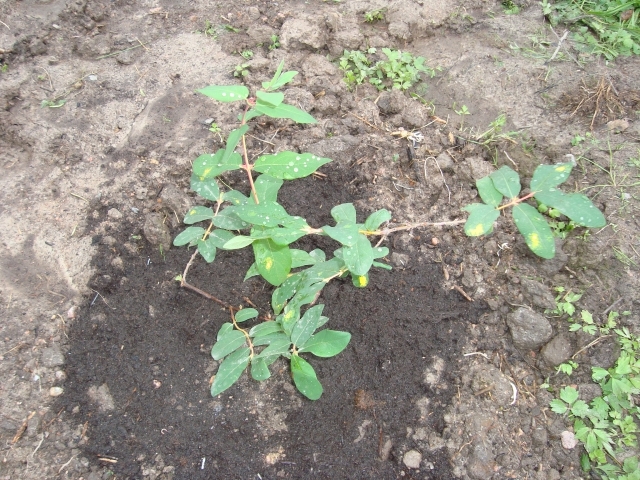
After planting, the seedling is watered abundantly, the soil is mulched, and at first it is watered very often
Care
Since the Nymph is very hardy, you should not be afraid for her fate after planting: if everything was done on time and according to the rules, in early spring the bush will resume its growth. In the coldest regions for the first winter, you can cover a young plant with coniferous spruce branches, but in early spring, the shelter must be removed.
Of the mandatory measures in the first two years after planting, the Nymph requires only regular watering, followed by shallow loosening of the soil and the destruction of weeds. At this time, until the bush gains strength, it has to be watered weekly. Subsequently, in standard, moderately rainy weather, the bush is watered once every 2-3 weeks, spending 1-1.5 buckets of water. Flowering and fruit setting is a particularly crucial period; at this time, the soil should not be allowed to dry out.
If there is a problem with watering, it is better to keep the honeysuckle under a layer of mulch of 8-10 cm all the time.
The third season after planting should already be with top dressing. On the frozen soil, under each bush of Nymph honeysuckle, 25–30 g of urea is scattered, and a little later, during the blooming of leaves, a bucket of humus is scattered and slightly embedded in the soil. At the end of summer, honeysuckle is fertilized in the same way with ash (up to a liter jar). Just before winter, half a bucket of compost and a handful of ash are scattered around the bush. In most cases, these fertilizers are sufficient, but sometimes it is worth adding a small amount (up to 40 g) of superphosphate.
Pruning begins to be required by the Nymph, starting from the fourth year, before that only broken and dried branches are removed. This should be done in the fall. When pruning, the weakest shoots are cut, and starting from the sixth year - the oldest ones (1-3 per season). With regular pruning after 12-15 years, there should be no shoots left in the bush that were in the first years of his life.
The nymph tends to thicken the crown. If this happens, thinning pruning is carried out, aimed at sufficient lighting and pollination of the berries that form in the central parts of the bush. If the tips of annual shoots freeze in the most severe winters, it is better to prune them, but this happens very rarely.
Nymph practically does not require spraying. At least for preventive purposes, this is not done. But if suddenly there is an attack of large quantities of aphids or leafworms, you will have to apply insecticides (Fitoverm, Iskra-bio, etc.) according to the instructions on the package.
Advantages and disadvantages of the Nymph in comparison with other varieties of honeysuckle
Despite its age (and since the appearance of Nymph honeysuckle, many new varieties have been obtained), the variety is very highly appreciated by experts and amateurs. The main advantages of the Nymph include:
- stable good yield;
- the highest frost resistance;
- unpretentious care;
- low susceptibility to pests;
- weak shedding of berries;
- versatility of crop use;
- great fruit taste.
The disadvantages are:
- short shelf life of fresh products;
- the possibility of secondary flowering;
- thickening of the crown;
- self-infertility.
Compared to most of the known varieties, connoisseurs distinguish Nymph as a variety that bears fruit with the most dessert flavor. Fresh they are considered some of the nicest gardeners have at their disposal. The sweet taste for honeysuckle is the exception rather than the rule: most varieties are slightly bitter, or even downright sour.
No more than a dozen varieties of honeysuckle are considered sweet. One of the best is Sibiryachka: his berries are somewhat larger, and the overall yield is slightly higher, but the word “dessert taste” is not used in relation to the berries of this variety. In addition, Sibiryachka berries are worse on the bushes. The Cinderella variety is wonderful: on small bushes, tasty berries ripen with characteristics close to those of the Nymph. Cinderella begins to bear fruit very quickly, but fruiting can take up to a month.
One of the most delicious is Silgink's honeysuckle, but the harvest is only on the litter: the berries are so fragile on the bushes. Well, the tasting rating of 5.0 has the berries of the Volshebnitsa honeysuckle variety, and many consider the Nymph even a sour berry compared to her, which is discussed in the next video.
Video: honeysuckle berries Nymph and Sorceress on the bushes
Thus, in terms of the totality of properties, Nymph cannot be considered the best variety, and this is natural: after all, now it is already one of the oldest varieties of honeysuckle. But she does not give up her positions and enjoys well-deserved popularity.
Reviews
If you want really not bitter, but tasty and even sweet, look for the varieties Nymph, Morena, Leningrad giant, Cinderella, Blue spindle. And do not look at the size of the berries - this is not always an indicator of their pleasant taste.
Of the three honeysuckles bearing the first year, Bakcharskaya, Morena and Nymph, I liked the taste of Bakcharskaya the most, followed by Nymph, and Morena is just sour.
VARIETIES FOR FIVE POINTS: very weakly crumbling, very large-fruited with exceptional taste: Souvenir, Slavyanka, Nymph, Violet, Assol, Izuminka, Leningrad giant.
Nymph, Amphora, Morena - good varieties, I grow. Whoever said that they are sour, let them also think that they were "vparili" and that they grow.
Honeysuckle is generally low-yielding, 1-2 kg from a very large bush - this is probably a record. Of my seven varieties, the sweetest was "Nymph". Almost acid free, despite bad weather in May - June. (The sweetness in the taste of honeysuckle very much depends on the sunny weather.) No wonder I was looking for it in stores, having read in the literature that the varieties "Nymph" and "Morena" taste very good.
Honeysuckle varieties Nymph is included in the list of the most famous representatives of this culture. Due to the excellent taste of the berries and the ease of cultivation, it is likely that it will not soon be replaced from the gardens of younger varieties.
